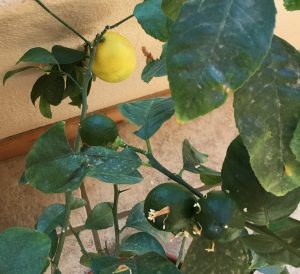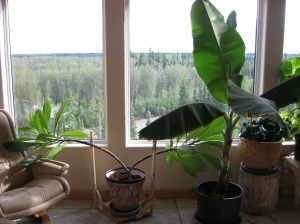Big strides have been made in the techniques and technology used for indoor gardening. From automation to LED lights to the proliferation of simple, functional hydroponic setups– indoor gardening in Alaska is more attainable than ever. With our short growing season, why not take advantage of the winter and grow something you can eat?
The most practical and productive things you can grow indoors would be microgreens, lettuce, herbs, cucumbers and tomatoes. For non-fruit bearing plants (greens, herbs, and lettuce), you don’t even need special grow lights, regular fluorescent lights will do. Some microgreens mature in as little as a week while many other types of greens mature in as little as three weeks.

Lemons ripen on my mom’s indoor-grown lemon bush. Photo by Maggi Rader.
While not as productive or practical, here are some of the indoor edibles on my wish-list are:
- Kaffir Lime Tree
- Lemon Grass
- Bay Laurel
- Brown Turkey Fig
- Calamondin Oranges (small, bitter oranges)
- Passion Flower
- Tamarillo Tree
I want to grow my own kaffir lime and lemon grass they are not readily available in town and the Thai recipes I cook always call for them. Fresh bay leaves are extra flavorful and since you need herbs in small quantities, I think I can produce enough to satisfy my need. One of my favorite pizza’s combines fresh figs, fig spread and bacon. Fresh figs are also difficult to find. Calamondin oranges are bitter, but more productive when grown in an indoor environment. Have you seen a passion flower? It’s a wild and beautiful thing that I would not mind having in my living room. Tamarillo trees are basically wild tomatoes. They take about two years to mature so of course they could not be grown outside. Fruits and vegetables that are closer to their wild ancestors tend to be more nutritious. Unfortunately, these exotic edibles are not as easy to grow as many houseplants, but maybe, some day, they will reward you with a tiny morsel to savor. Plus–bragging rights!
I interviewed my mom, Maggi Rader, who lives in Fairbanks, because she has grown a wide range of exotic plants. With floor to ceiling, south-facing windows that look out over the Tanana Flats, her home is ideal for indoor growing. She successfully has grown ripe lemons in her home. She has found that you have to be very careful when you transplant your citrus plants.
She’s also growing a coconut, plumeria, and passion flower, all of which she picked up small seedlings from the airport in Hawaii. She grew a banana to a nice size, but it didn’t produce fruit. She fertilizes every three weeks or so and uses a citrus specific fertilizer for her tropical plants.

The banana tree grew large, but did not bear fruit. Photo by Maggi Rader.
My mom has had a lot of problems with pests–in particular spider mites–but doesn’t have any pest problems right now. Dealing with pests is one of the more frustrating parts of growing indoor plants. Extension’s Houseplant Pest and Control Guide can help you troubleshoot the problem.
Holm Town Nursery, Fairbanks’ only local, year-round greenhouse sells some exotic indoor edible plants, especially in the spring and summer. Although they don’t special order plants, they do take input from gardeners on what they’re interested in purchasing. They also carry a wide variety of hydroponics setups if you’re interested in growing less exotic but more practical edibles like lettuce and greens.
Mile 5.2 Greenhouse in Eagle River carries a wider variety of exotic edible plants and ships them throughout Alaska. Some of the plants are quite mature and thus more expensive, but because they are more mature, it means you’ll be eating their fruits very soon. You can also order plants on the Internet from any number of greenhouses, but be sure to sleuth their shipping policies before shopping. You’ll also have to do more research and make sure that what you choose will be appropriate for indoor gardening. For example, look for plants with a dwarf or semi-dwarf habit or be prepared for a jungle to take over your house. When ordering exotic plants (or other species), do be aware of the potential for introducing invasive species and follow these simple guidelines.
In Indoor Edible Garden, Zia Allaway provides a wealth of inspiration. This Alaska specific website is also a wealth of information, especially for teachers hoping to garden in their classrooms.
Previously published in the Fairbanks Daily Newsminer December 22, 2019.